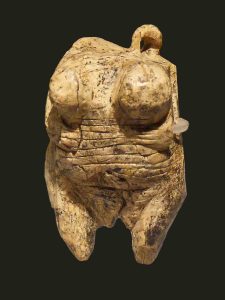Chapter 2 – Prehistory: Paleolithic and Neolithic Eras
Learning Objectives
- Be able to identify the characteristics and developments of the Paleolithic, Mesolithic, Neolithic Eras leading to the Bronze Age
Before the Rise of Civilization: The Paleolithic Era
The first humans evolved in Africa during the Paleolithic Era, or Stone Age, which spans the period of history from 2.5 million to about 10,000 BCE. During this time, humans lived in small groups as hunter-gatherers, with clear gender divisions for labor. The men hunted animals while the women gathered food, such as fruit, nuts and berries, from the local area. Simple tools made of stone, wood, and bone (such as hand axes, flints and spearheads) were used throughout the period. Fire was controlled, which created heat and light, and allowed for cooking.
Humankind gradually evolved from early members of the genus Homo such as Homo habilis , who used simple stone tools into fully behaviorally and anatomically modern humans ( Homo sapiens ) during the Paleolithic era. During the end of the Paleolithic, specifically the Middle and or Upper Paleolithic, humans began to produce the earliest works of art and engage in religious and spiritual behavior, such as burial and ritual. Paleolithic humans were nomads, who often moved their settlements as food became scarce. This eventually resulted in humans spreading out from Africa (beginning roughly 60,000 years ago) and into Eurasia, Southeast Asia, and Australia. By about 40,000 years ago, they had entered Europe, and by about 15,000 years ago, they had reached North America followed by South America.
During about 10,000 BCE, a major change occurred in the way humans lived; this would have a cascading effect on every part of human society and culture. That change was the Neolithic Revolution.
1. Paleolithic Culture
1.1 Paleolithic Society
A typical Paleolithic society followed a hunter-gatherer economy. Humans hunted wild animals for meat and gathered food, firewood, and materials for their tools, clothes, or shelters. The adoption of both technologies clothing and shelter cannot be dated exactly, but they were key to humanity’s progress. As the Paleolithic era progressed, dwellings became more sophisticated, more elaborate, and more house-like. At the end of the Paleolithic era, humans began to produce works of art such as cave paintings, rock art, and jewelry, and began to engage in religious behavior such as burial and rituals .
Early men chose locations that could be defended against predators and rivals and that were shielded from inclement weather. Many such locations could be found near rivers, lakes, and streams, perhaps with low hilltops nearby that could serve as refuges. Since water can erode and change landscapes quite drastically, many of these campsites have been destroyed. Our understanding of Paleolithic dwellings is therefore limited. (3)
1.2 Dwellings and Shelters
As early as 380,000 BCE, humans were constructing temporary wood huts . Other types of houses existed; these were more frequently campsites in caves or in the open air with little in the way of formal structure. The oldest examples are shelters within caves, followed by houses of wood, straw, and rock. A few examples exist of houses built out of bones.

Caves are the most famous example of Paleolithic shelters, though the number of caves used by Paleolithic people is drastically small relative to the number of hominids thought to have lived on Earth at the time. Most hominids probably never entered a cave, much less lived in one. Nonetheless, the remains of hominid settlements show interesting patterns. In one cave, a tribe of Neanderthals kept a hearth fire burning for a thousand years, leaving behind an accumulation of coals and ash. In another cave, post holes in the dirt floor reveal that the residents built some sort of shelter or enclosure with a roof to protect themselves from water dripping on them from the cave ceiling. They often used the rear portions of the cave as middens, depositing their garbage there.
In the Upper Paleolithic (the latest part of the Paleolithic), caves ceased to act as houses. Instead, they likely became places for early people to gather for ritual and religious purposes.
Modern archaeologists know of few types of shelter used by ancient peoples other than caves. Some examples do exist, but they are quite rare. In Siberia, a group of Russian scientists uncovered a house or tent with a frame constructed of mammoth bones. The great tusks supported the roof, while the skulls and thighbones formed the walls of the tent. Several families could live inside, where three small hearths, little more than rings of stones, kept people warm during the winter. Around 50,000 years ago, a group of Paleolithic humans camped on a lakeshore in southern France. At Terra Amata, these hunter-gatherers built a long and narrow house. The foundation was a ring of stones, with a flat threshold stone for a door at either end. Vertical posts down the middle of the house supported roofs and walls of sticks and twigs, probably covered over with a layer of straw. A hearth outside served as the kitchen, while a smaller hearth inside kept people warm. Their residents could easily abandon both dwellings. This is why they are not considered true houses, which was a development of the Neolithic period rather than the Paleolithic period. (3)
Key Takeaways
- The Paleolithic era is the span of time in which early members of the genus Homo evolved behaviorally and anatomically into the modern human (Homo sapiens).
- Key attributes of this evolving modern human are the use of a hunter gatherer economy, increasingly elaborate creation of clothing and shelter, and early evidence of art and religious behavior.
2. Paleolithic Cave Art and Venus Figurines
2.1. Paleolithic Cave Art
Archeological discoveries across a broad swath of Europe (especially southern France and northern Spain) include over two hundred caves with spectacular paintings, drawings, and sculpture that are among the earliest undisputed examples of representational image-making. Paintings and engravings along the caves’ walls and ceilings fall under the category of parietal art .
The most common themes in cave paintings are large wild animals, such as bison, horses, aurochs , and deer. Tracings of human hands and hand stencils were also very popular, as well as abstract patterns called finger flutings. The species found most often were suitable for hunting by humans, but were not necessarily the typical prey found in associated bone deposits. For example, the painters of Lascaux, France left mainly reindeer bones, but this species does not appear at all in the cave paintings; equine species are the most common. Drawings of humans were rare and were usually schematic as opposed to the detailed and naturalistic images of animals.
The pigments used appear to be red and yellow ochre , manganese or carbon for black, and china clay for white. Some of the color may have been mixed with fat. The paint was applied by finger, chewed sticks, or fur for brushes. Sometimes the silhouette of the animal was incised in the rock first, and in some caves, many of the images were only engraved in this fashion, taking them out of a strict definition of “cave painting.” (4)
Main Examples of Cave Paintings: France and Spain
3. Venus Figurines
“Venus figurines” is an umbrella term for a number of prehistoric statuettes of women that have been found mostly in Europe, but also in Asia and Siberia, dating from the Upper Paleolithic. These figures are all quite small, between 4 and 25 cm tall, and carved mainly in steatite, limestone, bone, or ivory. These sculptures are collectively described as “Venus” figurines in reference to the Roman goddess of beauty, as early historians assumed they represented an ideal of beauty from the time.
The Venus figurines have sometimes been interpreted as representing a mother goddess; the abundance of such female imagery has led some to believe that Upper Paleolithic (and later Neolithic) societies had a female-centered religion and a female-dominated society. Various other explanations for the purpose of the figurines have been proposed, such as the hypothesis that the figurines were created as self-portraits of actual women.
Venus figures are characterized by shared stylistic features, such as an oval shape, large belly, wide-set thighs, large breasts, and the typical absence of arms and feet. Hundreds of these sculptures have been found both in open-air settlements and caves.
The Venus of Hohle Fels, a 6 cm figure of a woman carved from a mammoth’s tusk, was discovered in Germany’s Hohle Fels cave in 2008 and represents one of the earliest found sculptures of this type.
Additionally, the Venus of Willendorf is a particularly famous example of the Venus figure. While initially thought to be symbols of fertility, or of a fertility goddess, the true significance of the Venus figure remains obscure, as does much of prehistoric art. (5)
- Figure 1-6: Venus of Willendorf by MatthiasKabel is licensed under CC BY-SA 3.0
- Venus of Hohle Fels by Catatine, CC BY-SA 4.0, via Wikimedia Commons
4. The Mesolithic Era
The Mesolithic Period, or Middle Stone Age, is an archaeological term describing specific cultures that fall between the Paleolithic and the Neolithic Periods. While the start and end dates of the Mesolithic Period vary by geographical region, it dated approximately from 10,000 BCE to 8,000 BCE.
The Paleolithic was an age of purely hunting and gathering, but toward the Mesolithic period the development of agriculture contributed to the rise of permanent settlements. The later Neolithic period is distinguished by the domestication of plants and animals. Some Mesolithic people continued with intensive hunting, while others practiced the initial stages of domestication. Some Mesolithic settlements were villages of huts , others walled cities. (6)
5. The Neolithic Era
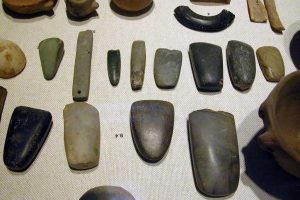
The term Neolithic or New Stone Age is most frequently used in connection with agriculture, which is the time when cereal cultivation and animal domestication was introduced. Because agriculture developed at different times in different regions of the world, there is no single date for the beginning of the Neolithic. In the Near East, agriculture was developed around 9,000 BCE, in Southeast Europe around 7,000 BCE, and later in other regions. Even within a specific region, agriculture developed during different times. For example, agriculture first developed in Southeast Europe about 7,000 BCE, in Central Europe about 5,500 BCE, and Northern Europe about 4,000 BCE. In East Asia, the Neolithic goes from 6000 to 2000 BCE.
Pottery is another element that makes the dating of the Neolithic problematic. In some regions, the appearance of pottery is considered a symbol of the Neolithic, but this notion makes the term Neolithic even more ambiguous, since the use of pottery does not always occur after agriculture: in Japan, pottery appears before agriculture, while in the Near East agriculture pre-dates pottery production.
Key Takeaways
- The Neolithic Era is when the domestication of animals and agriculture, particularly the cultivation of cereal became more common place.
6. A Revolution?
In order to reflect the deep impact that agriculture had over the human population, an Australian archaeologist named Gordon Childe popularized the term “Neolithic Revolution” in the 1940s CE. However, today, it is believed that the impact of agricultural innovation was exaggerated in the past: the development of Neolithic culture appears to have been a gradual rather than a sudden change. Moreover, before agriculture was established, archaeological evidence has shown that there is usually a period of semi-nomadic life, where pre-agricultural societies might have a network of campsites and live in different locations according to how the resources respond to seasonal variations. Sometimes, one of these campsites might be adopted as a basecamp; the group might spend the majority of time there during the year exploiting local resources, including wild plants: this is a step closer to agriculture. Agriculture and foraging are not totally incompatible ways of life. This means that a group could perform hunter-gatherer activities for part of the year and some farming during the rest, perhaps on a small scale. Rather than a revolution, the archaeological record suggests that the adoption of agriculture is the result of small and gradual changes.
Agriculture was developed independently in several regions. Since its origin, the dominant pattern in these separate regions is the spread of agricultural economies and the reduction of hunting and gathering activities, to the point that today hunting economies only persist in marginal areas where farming is not possible, such as frozen arctic regions, densely forested areas, or arid deserts.
Major changes were introduced by agriculture, affecting the way human society was organized and how it used the earth, including forest clearance, root crops, and cereal cultivation that can be stored for long periods of time, along with the development of new technologies for farming and herding such as plows, irrigation systems, etc. More intensive agriculture implies more food available for more people, more villages, and a movement towards a more complex social and political organization. As the population density of the villages increase, they gradually evolve into towns and finally into cities. (7)
7. Changes During the Neolithic Era
By adopting a sedentary way of life, the Neolithic groups increased their awareness of territoriality. During the 9600–6900 BCE period in the Near East, there were also innovations in arrowheads, yet no important changes in the animals hunted was detected. However, human skeletons were found with arrowheads embedded in them and also some settlements such as Jericho were surrounded with a massive wall and ditch around this time. It seems that the evidence of this period is a testimony of inter-communal conflicts, not far from organized warfare. There were also additional innovations in stone tool production that became widespread and adopted by many groups in distant locations, which is evidence for the existence of important networks of exchange and cultural interaction.
Living in permanent settlements brought new ways of social organization. As the subsistence strategies of Neolithic communities became more efficient, the population of the different settlements increased. We know from anthropological works that the larger the group, the less egalitarian and more hierarchical a society becomes. Those in the community who were involved in the management and allocation of food resources increased their social importance. Archaeological evidence has shown that during the early Neolithic, houses did not have individual storage facilities: storage and those activities linked to food preparation for storage were managed at village level. At the site of Jarf el Ahmar, in north Syria, there is a large subterranean structure which was used as a communal storage facility. This construction is in a central location among the households and there is also evidence that several rituals were performed in it.
Another site in northern Syria named Tell Abu Hureyra, displays evidence for the transition from foraging to farming: it was a gradual process, which took several centuries. The first inhabitants of the site hunted gazelles, wild asses and wild cattle. Then, we see evidence of change: gazelle consumption dropped and the amount of sheep consumption rose (wild in the beginning and domesticated in the end). Sheep herding turned into the main source of meat and gazelle hunting became a minor activity. Human remains show an increase of tooth wear of all adults, which reflects the importance of ground cereal in the diet. It is interesting that once pottery was introduced, tooth wear rates decreased, but the frequency of bad teeth increased, which suggests that baked food made from stone-ground flour was largely replaced by dishes such as porridge and gruel, which were boiled in pots. (7)
One of the best known prehistoric sites in the United Kingdom, Avebury contains the largest stone circle in Europe. Located in the same county as Stonehenge, Avebury lies north of the better-known site. Constructed over several hundred years in the third millennium BCE, the monument comprises a large henge with a large outer stone circle and two separate smaller stone circles situated inside the center of the monument. Its original purpose is unknown, although archaeologists believe that it was likely used for ritual or ceremony . The Avebury monument was part of a larger prehistoric landscape containing several older monuments.
The chronology of Avebury’s construction is unclear. It was not designed as a single monument but was the result of various projects undertaken at different times during late prehistory . Experts date the construction of the central cove to 3,000 BCE, the inner stone circle to
2,900 BCE, the outer circle and henge to 2,600 BCE, and the avenues to 2,400 BCE. The construction of Avebury and Stonehenge indicate that a stable agrarian economy had developed in this region of England by 4000 to 3500 BCE. (8)
Key Takeaways
- With an increasing sedentary way of life evidence of territorial conflict has been found.
- Larger groups of this time had less of an egalitarian and more hierarchical organization of society.
8. Neolithic Culture
Neolithic societies produced female and animal statues, engravings , and elaborate pottery decoration. In Western Europe, though, this period is best represented by the megalithic (large stone) monuments and passage tomb structures found from Malta to Portugal, through France and Germany, and across southern England to most of Wales and Ireland. (8)
Stonehenge
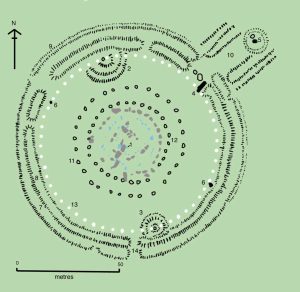
Perhaps the best known megalithic henge is Stonehenge, located on Salisbury Plain in the county of Wiltshire in south central England. Archaeologists believe it was constructed from 3000 BCE to 2000 BCE. The surrounding circular earth bank and ditch, which constitute the earliest phase of the monument, have been dated to about 3100 BCE. Radiocarbon dating suggests that the first bluestones in the innermost ring of Stonehenge were raised between 2400 and 2200 BCE, although they may have been at the site as early as 3000 BCE.
Although human remains have been found at the site, archaeologists are uncertain whether the site served funerarypurposes, ritual purposes, or both. Its alignments with the sunrise of the summer solstice and sunset of the winter solstice present the possibility that the site served as a rudimentary astronomical calendar to help early agrarian societies acclimate to the approaching growing season and harvest.
Even the smallest bluestones weigh several tons each. These stones, so-called because they appear blue when wet, were quarried approximately 150 miles away in the Prescelli Mountains in southwest Wales. Even more impressive, the quarrying and transport of the stones took place without the aid of the wheel, requiring a sophisticated method of transport and construction involving felled trees and earthen mounds. The larger Sarcen stones that form the post–and–lintel ring and he free-standing trilithons were quarried approximately 25 miles to the north of Salisbury Plain, requiring the same transport system of felled trees and earthen mounds. (8)
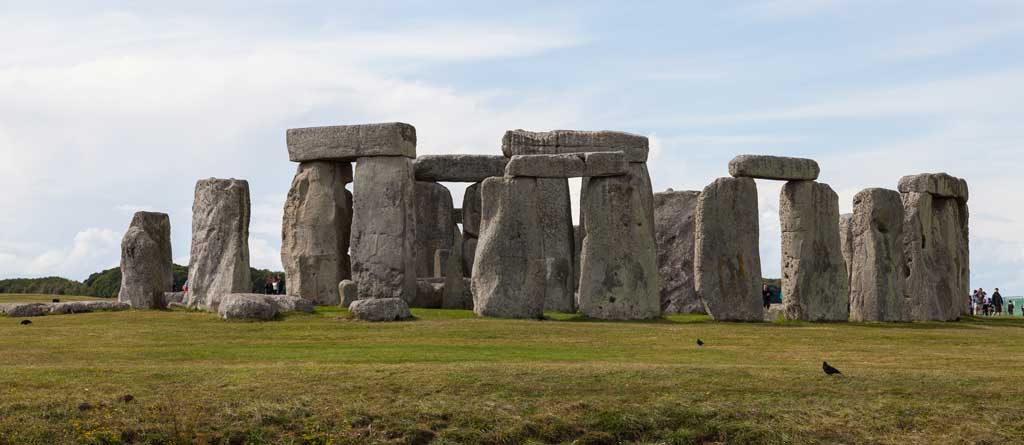
Even the smallest bluestones weigh several tons each. These stones, so-called because they appear blue when wet, were quarried approximately 150 miles away in the Prescelli Mountains in southwest Wales. Even more impressive, the quarrying and transport of the stones took place without the aid of the wheel, requiring a sophisticated method of transport and construction involving felled trees and earthen mounds. The larger Sarcen stones that form the post–and–lintel ring and he free-standing trilithons were quarried approximately 25 miles to the north of Salisbury Plain, requiring the same transport system of felled trees and earthen mounds. (8)
Avebury
Passage Tombs
Passage tombs or graves consist of narrow passages made of large stones and one or multiple burial chambers covered in earth or stone. Megaliths were commonly used in the construction of passage tombs and typically date to the Neolithic. A common layout is the cruciform passage grave, characterized by a cross-shaped structure.
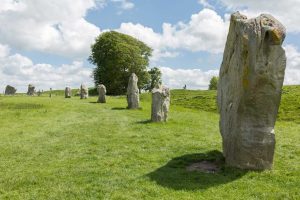
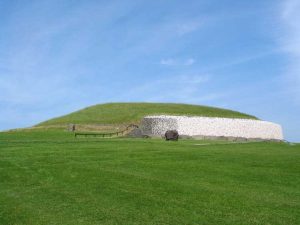
The Newgrange monument is comprised of a large mound built of alternating layers of earth and stones, covered with growing grass and with flat white quartz stones studded around the circumference. The mound covers 4500 square meters of ground. Within, a passage stretches through the structure ending at three small chambers
Newgrange contains various examples of abstract Neolithic art carved onto its rocks. These are separated into 10 categories consisting of curvilinear forms like circles, spirals, arcs, serpentiforms, and dot-in-circles, as well as rectilinear examples such as chevrons, lozenges, radials, parallel lines, and offsets.
There is no agreement as to what the site was used for, but it has been speculated that it had some form of religious significance due to its alignment with the rising sun which floods the stone room with light on the winter solstice.(8)
Key Takeaways
Type your key takeaways here.
- Female and animal statues, engravings, and elaborate pottery were prevalent during the Neolithic Era.
- In Western Europe megalithic monuments and passage tomb structures were created
9. The End of the Neolithic Era

At least two factors mark the transition from the prehistoric era to the ancient era. The first is the transition from stone to metal. Towards the end of the Neolithic era, copper metallurgy is introduced, which marks a transition period to the Bronze Age, sometimes referred to as the Chalcolithic or Eneolithic Era. Bronze is a mixture of copper and tin, which has greater hardness than copper, better casting properties, and a lower melting point. Bronze could be used for making weapons, something that was not possible with copper, which is not hard enough to endure combat conditions. In time, bronze became the primary material for tools and weapons, and a good part of the stone technology became obsolete, signaling the end of the Neolithic and thus, of the Stone Age. (7)
The second factor is the transition from oral storytelling to writing. Whereas prehistoric peoples depended upon word of mouth and images to pass along their culture and traditions, by 3000 BCE, humans living in Mesopotamians begin creating a written script to record their ideas. With this innovation in human history, the shift from pre-recorded history to recorded history begins. (1)
Key Takeaways
- The transition from stone to metal, and oral storytelling to writing are key attributes marking the transition from the prehistoric era to the ancient era.
Reading Questions
Assess your comprehension:
- What are the distinguishing features of the Paleolithic, Mesolithic, Neolithic Eras?
- What developments through out the ages assisted in the technological and societal advancements of humans?
Critical Thinking Questions:
- What are the traces of the prehistoric eras in the contemporary human society?
- What specific designs and/or activities in the contemporary human society implicate the prehistoric eras?
- Given your relative understanding of the prehistoric era, how would you assess human lives and society in the contemporary society?


